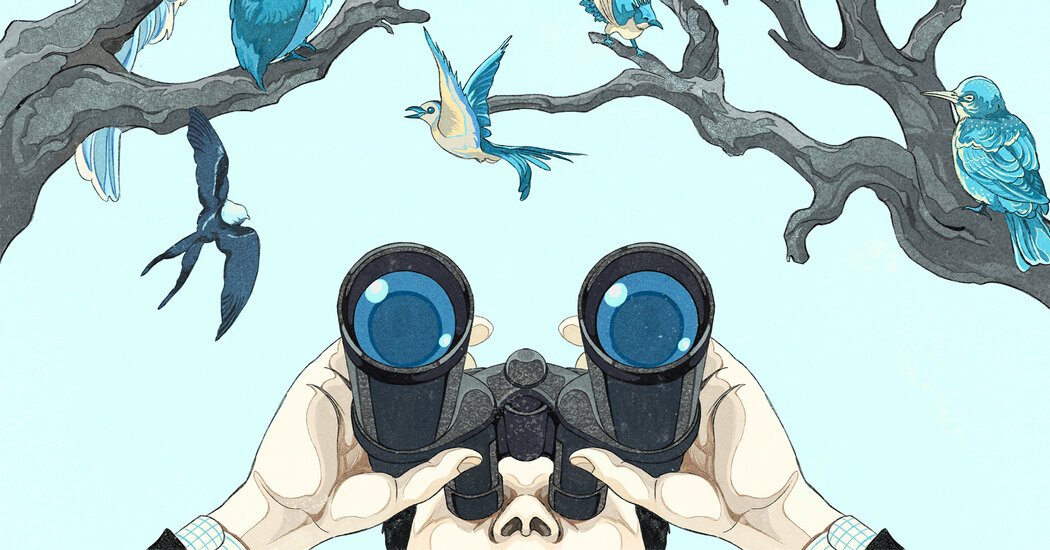
According to a survey from the U.S. Fish and Wildlife Service, 96 million Americans are bird-watchers, or 37 percent of the population aged 16 and above. Most observe from home, but 43 million have traveled a mile or more to go birding.
Amy Tan, author of the book “The Backyard Bird Chronicles,” knows why.
“Birds are some of the most magical animals on earth,” Ms. Tan said. “They fly, they sing crazy beautiful songs, they have amazing navigational systems that feel the magnetic force of the universe and guide themselves by the sun and the moon.”
Because birding can be done almost anywhere and requires little gear, it’s an easy activity to pick up and a practice suitable to many trips. Here’s how to get started.
Hone your powers of observation
Bird-watching requires observing not just a bird’s appearance but its behavior.
“Is it quick, slow, frenetic, soaring or staying in the underbrush?” said Nate Swick, the education and digital content coordinator for the nonprofit American Birding Association and the author of “The Beginner’s Guide to Birding.” “Those are clues as much as colors and patterns.”
Most experts suggest starting in your backyard or neighborhood park and learning the local resident birds to refine your birding skills before you take them on the road.
Download apps
In the digital age, apps have made birding easier than paging through field guides by offering step-by-step processes that narrow down a list of possible birds or identify a bird by its song.
The free app Merlin Bird ID from the Cornell Lab of Ornithology does both. Also free, the Audubon Bird Guide app from the nonprofit conservation group uses visual input to identify birds and displays a tally of birds seen. Both apps allow the user to search according to geographical area so they are handy for travelers, and both can be used offline.
Don’t forget binoculars
Binoculars are graded by two sets of numbers, such as 8×30, explained Chris Harbard, the president of the Southwest Wings birding festival in Sierra Vista, Ariz., who has worked as a birding expert for Silversea Cruises.
The first number indicates the degree of magnification. As the magnification number gets larger, so does the size of the set, making them harder to carry and hold steady.
The second number relates to the diameter in millimeters of the lens at the larger end of the binoculars. The bigger the number, the more light the lens admits, making the image you see brighter and clearer.
While mini travel binoculars provide some magnification, Mr. Harbard recommended starting with 8×30 or 8×32, which are not too bulky to pack, though choosing the right set is an individual choice.
Good starter binoculars are estimated to run about $200 to $250. Make sure they have rain covers for the eyepieces and look for binoculars that are labeled “sealed” or “nitrogen filled,” which prevents moisture from condensing inside the lenses.
Dress for success
If birders often look like they could be on safari, there’s a reason.
“You don’t want to stand out to a bird,” Mr. Harbard said, noting anything bright and light like white or yellow are conspicuous. “If you are not seen, you will see a lot of birds.”
Birders should wear comfortable shoes that allow them to stand or walk for long periods. Make sure they are closed-toed in places like the tropics where your feet can be vulnerable to insect bites. Carry a backpack with a waterproof or warm layer, snacks, sunscreen, bug spray and water.
Incorporate birding into travel
Birding can be part of nearly any journey. Travelers can look up chapters of Audubon to find area events like bird walks or use a website like Birding Pal to find local birders and volunteer guides (annual subscriptions, $10).
“There are opportunities in every state to visit birding hot spots or trails, which are collections of good birding spots,” said Brooke Bateman, the senior director of climate and community science for Audubon.
Birding trails such as the Great Texas Coastal Birding Trail often present opportunities for convenient road-trip routes.
Up the odds by viewing a migration
Traveling to witness a migration — such as the warblers that visit northwest Ohio each spring, an event celebrated as the Biggest Week in American Birding festival — can reduce the risk of disappointment inherent in wildlife watching.
“Birding can be like fishing sometimes; you never know exactly what you’re going to get and it can be slow,” said Mr. Swick of the A.B.A. “But migrations are more of a guarantee.”
Graduate to a birding trip
Birding-specific trips offer opportunities to see specific or rare species, from snowy owls in Minnesota to resplendent quetzals in Costa Rica.
“The tropics is where diversity is at,” said Kathi Borgmann, an ornithologist and the communications manager at the Cornell Lab of Ornithology, highlighting the band around the Equator. In a place like Mindo, Ecuador, she added, birders might see 50 to 100 species in a day.
Birding trips often specify the degree of physical activity required. Naturalist Journeys, a tour company specializing in birding and nature, has trips at “a birder’s pace” and more active ones labeled “humming along.”
Expect an early-to-bed, early-to-rise schedule. On its website, the birding-focused tour company Wings publishes a guideline on what to expect, including possible pre-breakfast birding walks, walking for up to six hours a day and taking a midday break in warmer climates.
“Birding makes anywhere you go special,” said Mr. Swick. “Like local food, local birds are distinct.”



